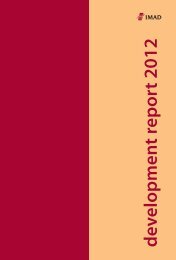The Development of New Industrial Relations in Slovenia - UMAR
The Development of New Industrial Relations in Slovenia - UMAR
The Development of New Industrial Relations in Slovenia - UMAR
Create successful ePaper yourself
Turn your PDF publications into a flip-book with our unique Google optimized e-Paper software.
1994 (Stanojevič, Omerzu, 1994) it was estimated, that around 60% <strong>of</strong> all workers<br />
(the rate <strong>of</strong> union density) were members <strong>of</strong> trade unions. <strong>The</strong> survey shoved, that<br />
59,6% <strong>of</strong> the total active population were members <strong>of</strong> trade unions (and 4,6% <strong>of</strong> the<br />
non - active population), and 63,5% <strong>of</strong> all employed persons (23,3% <strong>of</strong> unemployed).<br />
Among “white collar” workers 54,9% were trade union members and among “blue<br />
collar” workers 75,9%. As said already,, membership <strong>in</strong> trade unions fell from<br />
practically 100% before 1990 to 63.5% <strong>in</strong> 1994 and (accord<strong>in</strong>g to a new telephone<br />
surwey) to about 42% <strong>in</strong> 1999. It now ranges close to the European average, which<br />
is around 40% (OECD, 1991).<br />
COMPARISON 1 OF TRADE UNION DENSITY AND COLLECTIVE BARGAINING COVERAGE IN<br />
1990 - 1994<br />
Trade union density 2 Collective barga<strong>in</strong><strong>in</strong>g coverage 3<br />
1990 1994 1990 1994<br />
Sweden 83 91 86 89<br />
F<strong>in</strong>land 72 81 95 95<br />
Denmark 71 76 69 69<br />
Norway 56 58 75 74<br />
Belgium 51 54 90 90<br />
Austria 46 42 98 98<br />
Italy 39 39 83 82<br />
Canada 36 38 38 36<br />
Australia 41 35 80 80<br />
England 39 34 47 47<br />
Portugal 32 32 79 71<br />
<strong>New</strong> Zealand 45 30 67 31<br />
Germany 33 29 90 92<br />
Switzerland 27 27 53 50<br />
<strong>The</strong> Netherlands 26 26 71 81<br />
Japan 25 24 23 21<br />
Spa<strong>in</strong> 13 19 76 78<br />
U.S.A. 16 16 18 18<br />
France 10 9 92 95<br />
SLOVENIA 100 64 100 100<br />
Sources <strong>of</strong> data: OECD: Employment Outlook. July, 1997; Stanojevič M., Omerzu M.:<br />
Javnomnenjske podobe s<strong>in</strong>dikatov. Ljubljana, 1994. Notes: 1 countries are ranked accord<strong>in</strong>g to the<br />
trade union density <strong>in</strong> 1994, 2 trade union density: percentage <strong>of</strong> trade union members <strong>in</strong> all<br />
employees, 3 collective barga<strong>in</strong><strong>in</strong>g coverage: percentage <strong>of</strong> workers <strong>in</strong> total employees whose<br />
employment conditions are def<strong>in</strong>ed <strong>in</strong> collective agreements.<br />
Collective barga<strong>in</strong><strong>in</strong>g coverage (CBC) is the share <strong>of</strong> workers whose employment<br />
conditions are def<strong>in</strong>ed by collective agreements <strong>in</strong> all employees (OECD, 1997). <strong>The</strong><br />
coverage rate depends on the share <strong>of</strong> workers belong<strong>in</strong>g to trade unions, the share<br />
<strong>of</strong> employers belong<strong>in</strong>g to employers’ organisations and the authorities’ use <strong>of</strong><br />
statutory mechanisms <strong>in</strong> extend<strong>in</strong>g collective barga<strong>in</strong><strong>in</strong>g agreements. In most<br />
countries, collective barga<strong>in</strong><strong>in</strong>g coverage is higher than membership <strong>in</strong> trade unions.<br />
France is the extreme case, comb<strong>in</strong><strong>in</strong>g the lowest unionisation rate and one <strong>of</strong> the<br />
highest coverage rates. <strong>The</strong> reasons are: employers may extend collective<br />
agreements to non-union workers, or authorities may extend the validity <strong>of</strong> collective<br />
12
















